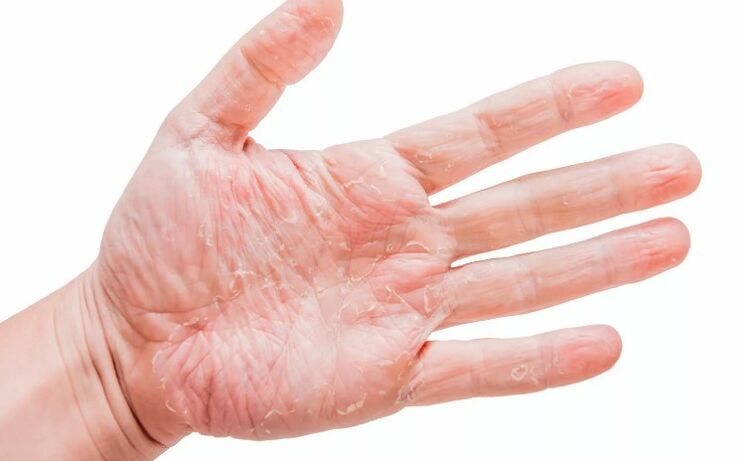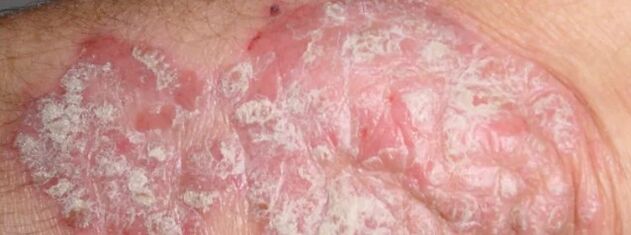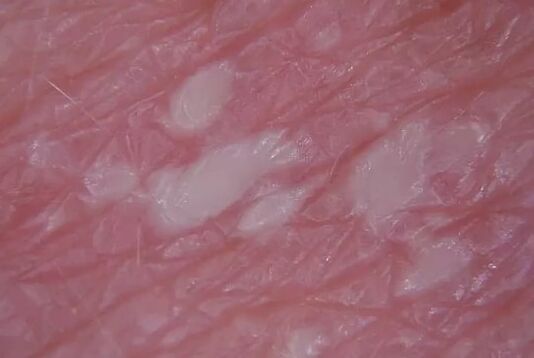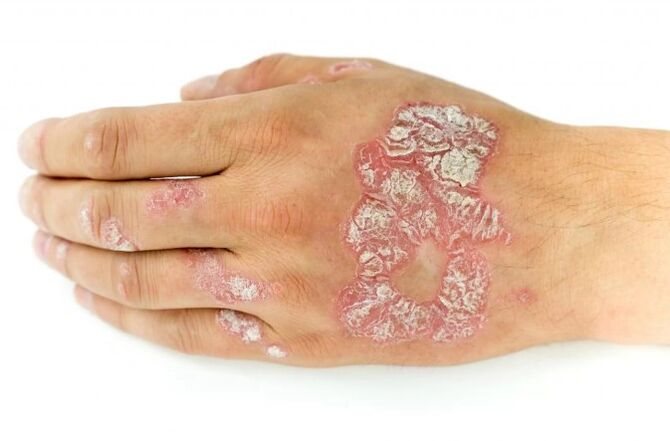Psoriasis is a chronic dermatological disease, the basis of pathogenesis which is an abnormal growth of skin cells, leading to appearance on the surface of the skin that is compacted from a variety of colors.
Today, psoriasis has become an unusual dermatological disease.Psoriasis has no gender tendency -both men and women suffer from them.You can get this pathology at any age, but more often the first signs of the disease appear for up to 20 years.

Psoriasis is relatively poor in therapy, partly due to the fact that so far the etiology and pathogenesis of pathology are still unclear.In addition, there is no way to prevent certain psoriasis, as it is impossible to determine if a person has a tendency for the disease.
The grounds of development
Currently, scientists cannot answer the question "Why is psoriasis growing?".The two main factors of the development of the disease are distinguished - these are the genetic tendencies and hyperreviews of the immune system.
Has been set so farThe tendency for the development of psoriasis is inherited.But the difficulty lies in the fact that it is very difficult to detect how accurate this tendency is and after the influence of psoriasis factors can develop.
It is believed that the following factors can drive the development of psoriasis:
- Frequent skin hypothermia, as well as dry climate effects on it;
- Contagious processes;
- Frequent stress;
- The use of several pharmaceutical groups: anti -non -ssteroid drugs (especially aspirin), some hypotonic and psychotropic drugs;
Pathogenesis
Currently, psoriasis pathogenesis has not been explained.Two main links of pathogenesis can be distinguished:
- Violation of skin keratinization.
- Disruption of the immune system.
Together, the above factors lead to the fact that the cells of the bottom layer of the epidermis for unknown reasons begin to share quickly.This process leads to reactive increases in the withering rate of the upper layer of the epidermis, which is created externally by peeling the skin.
Symptom
The disease always begins with acute, without any harbinger development of the pathological process.As a rule, the first elements of the rash are located in a place where the skin is damaged.
At the beginning of the symptoms of psoriasis, pink or red papules appear on the skin.This process is accompanied by itching.The size of the element -the element ranges from a few millimeters to 1.5 centimeters (in some cases, the elements reach a large size).Then the elements of the rash are covered with a silver scale that is easily separated.
Sometimes psoriasis damage the nail plate.This pathology externally resembles fungal damage to the nails and is indicated by the following symptoms:
- There are many small holes on the surface of the nail;
- The edge of the nail plate thickens and obtains dull, yellowish color;

Another manifestation of psoriasis features is psoriatic arthritis (symmetrical damage to the joints and periartic tissue).Often, the pathological process develops in the joints between the feet and hands.Initially, the disease was characterized by pain and swelling, and then deformation of the affected joints developed, which could even cause the patient's defect.Keep in mind that in rare cases, damage is also possible.Sometimes psoriatic arthritis develops even at the spinal column joints.
Type
The following types of psoriasis are distinguished depending on the severity and characteristics of clinical manifestations:
- Plaquaper.This type is the most common - it is diagnosed in almost 90% of people suffering from psoriasis.Elements of rash, theoretically, can occur anywhere in the skin.However, the most common localization is the lower back, scalp and upper and lower extensors (elbow and knee areas).Keep in mind that with this form of psoriasis, pathological elements do not appear on the face, palms and feet.Outside, this shape looks like an inflamed plaque covered with silver on a scale.When the plaque is displayed from the bottom of the scale, the Lymph is released.With further injury, the plaque began to bleed.The form of psoriasis plaque is also characterized by a coordinated "paraffin lake" appearance - a meeting of several plaques in one element.
- Inverted psoriasis (flexible or intertrigonic surface psoriasis).This form is quite rare.The rash elements have a red spots without peeling, which does not stand out on the surface of the skin.Typical localization of this form of psoriasis - skin folds (axillary cavity, inguinal folds, skin under the chest in women).Also, due to the features of localization, fungal infections often participate in reverse psoriasis.
- Genital psoriasis.This form is most often developed in girls, especially in adolescence (up to 16 years).Often the development of pathological processes is preceded by streptococcal infections (for example, angina).Rash with rocky psoriasis resembles a normal allergic rash - a small dot that has a color from gray to purple, not prominent on the surface of the skin.Such rash can appear anywhere in the skin.The skin where the rash is located, as a rule, has an inflamed appearance.
- Pustulenia psoriasis.It is a worse shape than the above.With pustular psoriasis, painful small pale is filled with pus appears in the patient's body.This form can take place inside and in general.With pustular psoriasis, the general condition of the patient often worsens, body temperature increases.With the form of general pustular psoriasis, hospitalization is required.
- Erytroderma is the worst form of psoriasis.Thus, almost the entire skin of the patient is damaged.This form is accompanied by chills, increased body temperature to high numbers, sharp deterioration in the patient's condition.The disease requires immediate medical intervention, without the cause of death.

X
There are many different grades of psoriasis in terms of severity.However, in routine clinical practice, the most commonly used most commonly used, which does not require any special research method.
Thus distinguishThree degrees of severity of psoriasisDepending on the prevalence of the pathological process:
- Lightweight shape.This form is prescribed in cases where the patient is influenced by psoriasis less than 3% of the skin.
- Medium form.This diagnosis is made with psoriasis damage from 3 to 10% of the patient's skin.
- Heavy shape.This form is displayed taking into account skin wounds and clinical manifestations.Therefore, this form is displayed with a wound of more than 10% of the skin or with a significant deterioration in the well -being of the patient.It should be noted that psoriasis is considered severe in the presence of psoriatic arthritis, regardless of the level of prevalence of pathological processes.
The journey of illness and prognosis
Psoriasis is a disease with courses such as waves, that is, it has a period of remission (when the symptoms are lost) and severity.As a rule, the process is aggravated during the season.
Prognosis for psoriasis depends on the form of the disease and severity.As a rule, with classic forms of psoriasis, prognosis is good, but in severe forms, defects are possible and even death.
Despite favorable prognosis in most forms of psoriasis, do not forget the social aspects of the disease.During the acute disease, the skin and hairy parts of the human head are covered with peeling plaques, which are often seen by others as a manifestation of infectious diseases.Because of this, the people around them begin to avoid the patient, which causes him to close, and often depression.
Diagnostics

The basis for diagnosis is a clinical manifestation of a disease, current features, as well as objective inspection data.There are some characteristic symptoms specified for the diagnosis of psoriasis:
- "Psoriatic film" - if you clean the surface of the papule peeling, then it becomes smooth and shiny.
- "Stearin Stain" - when the psoriatic elements are displayed, the surface becomes white, Starin films appear.
- "Blood Hall" - If, after the manifestation of the above symptoms, do not stop sling the elements, then the surface is covered with blood drops (capillary bleeding appears).
The three symptoms described above are called "psoriatic triads" and are a major method of diagnosis of psoriasis.However, there are several other signs specified in certain stages of the disease:
- In the stage of acute psoriasis, the symptoms of pilnov are caused (psoriatic elements surrounded by red rims) and kekner (new rash appears in damaged areas).
- The level of regression also determines the symptoms of voronov (around elements of excellent light rims of wrinkled skin).
Laboratory and instrumental methods, the following are used:
- Scale and dough microscopy with potassium hydroxide (for differential diagnosis of fungal skin damage).
- In complex clinical cases, with atypical courses, pathological elements use biopsy.
- With psoriatic arthritis, blood test indicators are examined (especially ESR and rheumatoid factors) and run X -Rays affected joints (for differential diagnosis with other etiological arthritis).

Treatment
Treatment of psoriasis is a long and complex process.Unfortunately, since psoriasis is a chronic disease, the purpose of therapy is not a patient's healing, but a prolonged remission achievement and prevention of severity.Treatment depends on the stage, shape and severity of psoriasis.It should be noted that a set of medical steps must be prescribed by a dermatologist and only after a thorough examination of the patient and confirmation of diagnosis.
Diet.Treatment of psoriasis should start with a dietary correction of the patient's daily diet.If we talk about general suggestions, then people with psoriasis should reduce the amount of protein in the diet and increase the amount of carbohydrates due to the use of vegetables and fruits.It is also necessary to exclude products that can cause psoriasis problems: alcohol, chocolate, various spices, as well as limit the use of garlic and onions.It is also worth limiting the use of fried meat and fish, smoked meat.
Also, when compiling an optimal diet, the patient's tendency to allergies to any product and, if possible, excluding them should be taken into account.The optimal diet is the use of a large number of vegetables and vegetables -a variety of meat and fish and fish in the form of boiled.
Drug treatment.For the treatment of psoriasis, pharmaceuticals are used in various forms of release: ointment, tablets, injections, etc.
In addition to local medicines, system therapy is also used, when drugs are prescribed in the form of tablets or injections.The following drugs are most frequently prescribed:
- Immunosuppressants.They have a huge impact on the immune system.It is only prescribed in severe cases that are not acceptable to other therapeutic methods, as they have a large number of side effects and are difficult to transfer.
- Cytostatics.Its action is aimed at reducing the rate of cell division, leading to a decrease in the development rate of psoriasis and decreasing peeling.It is only used in very severe cases, with durability of other therapy methods.
- Various homeopathic remedies.Unfortunately, these medicines are not suitable for all patients and do not always have the necessary effects.

Photochemotherapy.Lighting is one of the main methods of psoriasis therapy.
In conclusion, it should be noted that psoriasis is a complex disease and is not fully studied.A qualified doctor must be done with treatment.Remember that no magic methods are praised on the internet will help you get rid of your own psoriasis.
The same thing can be said about folk medicine - all of its methods will only benefit in combination with basic medicines prescribed by doctors.
Therefore, we can conclude that in order to achieve success in treatment, patients only need to use the methods that he or she agrees with the attending physician, as well as observing all his recommendations.This is the only way to achieve good success in the treatment and remission of prolonged psoriasis.























